<< Previous | Displaying results 3101-3150 of 6769 for "" | Next >>
Reproduction of the first page of an addendum to the Reich Citizenship Law of September 15, 1935. This is the first of 13 addenda to the original legislation that were issued from November 1935 to July 1943 in order to implement the policy aims of the Reich Citizenship Law.
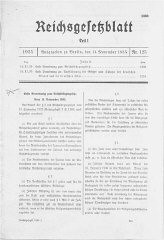
Chart with the title "Die Nürnberger Gesetze" [Nuremberg Race Laws]. In the fall of 1935, German Jews lost their citizenship according to the definitions posed in these new regulations. Only "full" Germans were entitled to the full protection of the law. This chart was used to aid Germans in understanding the laws. White circles represent "Aryan" Germans, black circles represent Jews, and partially shaded circles represent “mixed raced” individuals. The chart has columns explaining the…
![Chart with the title "Die Nürnberger Gesetze" [Nuremberg Race Laws]](https://encyclopedia.ushmm.org/images/thumb/109130bd-4617-43ad-a556-d2955f1a4aa3.jpg)
Eugenics poster entitled "The Nuremberg Law for the Protection of Blood and German Honor." The illustration is a stylized map of the borders of central Germany upon which is imposed a schematic of the forbidden degrees of marriage between Aryans and non-Aryans and the text of the Law for the Protection of German Blood. The German text at the bottom reads, "Maintaining the purity of blood insures the survival of the German people."
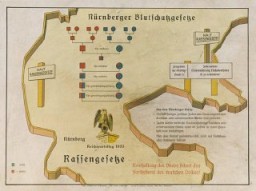
33rd Nazi propaganda slide of a Hitler Youth educational presentation entitled "Germany Overcomes Jewry." The text in German reads: "Zum Schutze des deutschen Blutes vor fremdrassiger Vermischung erliess der Fuhrer die." Translation: "For the protection of German blood against alien race mixing the Führer issued Nuremberg Laws."

This image shows a 1935 poster by the antisemitic Der Stürmer (Attacker) newspaper. The poster justifies prohibiting “interracial” relationships between Jews and non-Jews under the Nuremberg Race Laws. Many Germans reported suspicions of the “crime” of interracial relationships to the police. The police needed the public to be their “eyes and ears” in this and other matters. Informers were variously motivated by political beliefs, personal prejudices, the desire to settle petty quarrels, or…
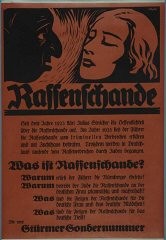
Fritz Glueckstein (left) on a picnic with his family in Berlin, Germany, 1932. Fritz's father was Jewish—he attended services in a liberal synagogue—and his mother was Christian. Under the Nuremberg Laws of 1935, Fritz would be classified as mixed-raced (Mischling), but since his father was a member of the Jewish religious community, Fritz was classified as a Jew.
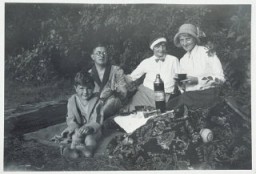
Two Jewish girls (cousins Margot and Lotte Cassel) ready for their first day of school in Breslau, Germany, ca. 1937. As was traditional for all children in Germany, the cones were filled with treats to celebrate their first day of school. Margot's father, Saul, worked in the Tietz department store until he was dismissed following the enactment of the Nuremberg Laws.
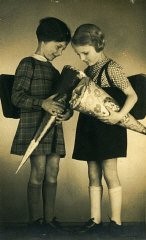
Funeral procession for victims of the Kielce pogrom. Kielce, Poland, July 1946.
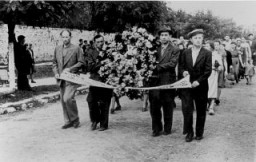
Mourners and local residents shovel dirt into the mass grave of the victims of the Kielce pogrom during the public burial.
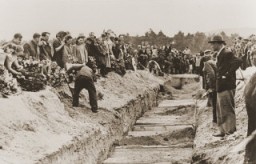
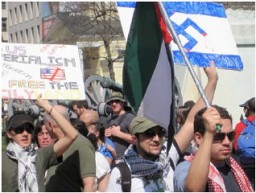
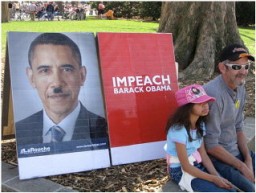
The cover of a diary written by Elizabeth Kaufmann while living with the family of Pastor André Trocmé in Le Chambon-sur-Lignon. Le Chambon-sur-Lignon, France, 1940–41.
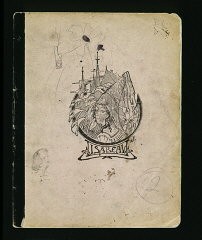
Page from a diary written by Elizabeth Kaufmann while living with the family of Pastor André Trocmé in Le Chambon-sur-Lignon. Le Chambon-sur-Lignon, France, 1940–41.
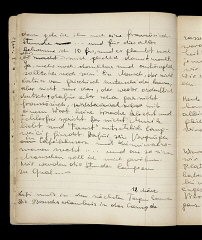
Illustrated page of a child's diary written in a Swiss refugee camp. The diary entry describes how they crossed the border into Switzerland. The text reads, "We came out of the woods and into a clearing: we had to be as quiet as possible because we were so close to the border. Oh! I almost forgot! Before we came out of the woods, they made us stand still for a quarter of an hour while they went to explore the area and to cut through the fence. Fortunately, shortly thereafter, we began to walk again. We saw…
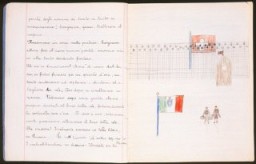
Illustrated page of a child's diary written in a Swiss refugee camp. The diary entry describes how they crossed the border into Switzerland. The text reads, "We came out of the woods and into a clearing: we had to be as quiet as possible because we were so close to the border. Oh! I almost forgot! Before we came out of the woods, they made us stand still for a quarter of an hour while they went to explore the area and to cut through the fence. Fortunately, shortly thereafter, we began to walk again. We saw…
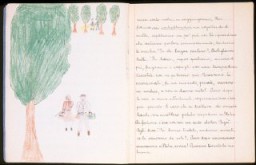
Otto Wolf (1927-1945) was a Czech Jewish teenager who chronicled his family's experience living in hiding in rural Moravia during World War II. His diary was published posthumously. This image shows book 4 of Otto Wolf's diary. This is the first entry by Felicitas Garda (Otto Wolf's sister) dated April 17, 1945. Felicitas continued Otto's diary after his disappearance.
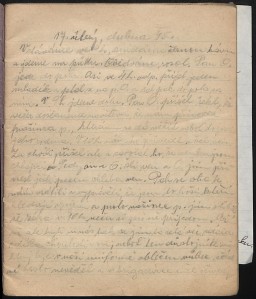
Kitty Weichherz, pictured here in a photograph taken before World War II began, was born in December 1929. This photo was taken from a diary of Kitty's life written by her father, Bela Weichherz. After Kitty's birth, Bela started to keep a diary of his daughter's life. He made entries recording her childhood in Czechoslovakia until the family was separated and deported during the Holocaust. His last entry reads "I only wish that we can go together." Kitty and all of her immediate family perished in the…
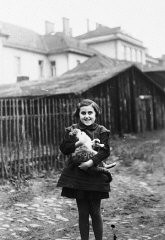
Defendant John Demjanjuk comments on documents being viewed on a large screen in court. Jerusalem, Israel, July 27, 1987.
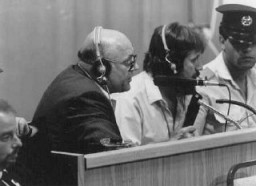
Defendant John Demjanjuk crosses his heart upon hearing the pronouncement of his death sentence. Jerusalem, Israel, April 25, 1988.

At Der ewige Jude (The Eternal Jew), a Nazi anti-Jewish propaganda exhibition, a case features "typical Jewish external features." Munich, Germany, November 1937.
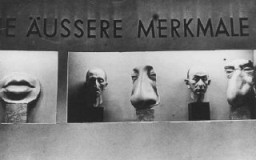
A notice posted by a student group calling for Romanians to protest against the rights of Jews. Iasi, Romania, 1941–1942.
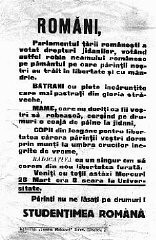
Insignia of the 30th Infantry Division. The nickname of the 30th Division was Old Hickory, named after President Andrew Jackson.
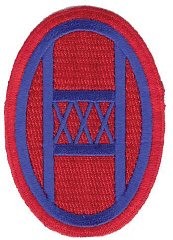
Marc Chagall, the Russian Jewish artist, at work in his studio in southern France. Gords, France, 1940.
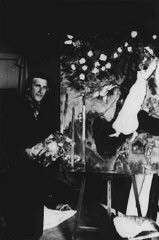
Max Brod, a Czech-born Jewish author and composer who wrote in the German language. An active Zionist, he succeeded in leaving for Palestine in 1939. Prague, Czechoslovakia, February 27, 1937.
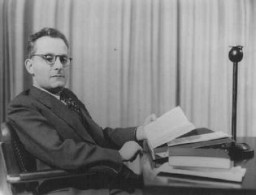
Sigmund Freud: Massenpsychologie und Ich-Analyse, cover. In 1933, Nazi students at more than 30 German universities pillaged libraries in search of books they considered to be "un-German." Among the literary and political writings they threw into the flames were all the works of Sigmund Freud that were published by 1933.
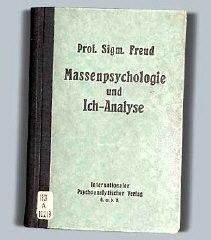
Portrait of Sigmund Freud. Freud's writings were burned during the 1933 book burnings.
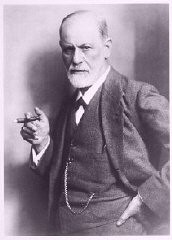
Thomas Mann, seen here in Germany before the war, was a noted German novelist and Nobel Laureate. He denounced the Nazis and emigrated to the United States in 1938 after his German citizenship was revoked. Germany, prewar.
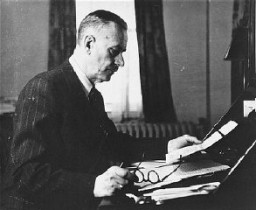
Jan Karski, underground courier for the Polish government-in-exile, informed the West in the fall of 1942 about Nazi atrocities against Jews taking place in Poland. Washington, DC, United States, 1943.
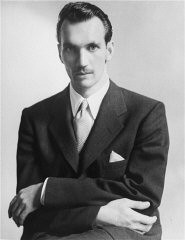
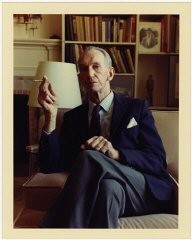
Jan Karski and General Colin Powell meet during the opening ceremonies of the US Holocaust Memorial Museum. Washington, DC, April 22, 1993.
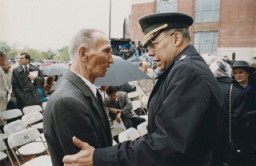
An Armenian woman and her child sit on a sidewalk next to a bundle of their possessions. Ottoman Empire, 1918–20.
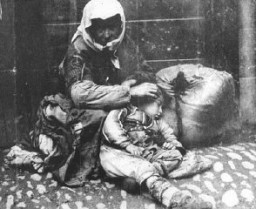
Studio portrait of two Armenian girls wearing traditional clothing. Ottoman Empire, ca 1895. [Courtesy of Mabel Aharonian]
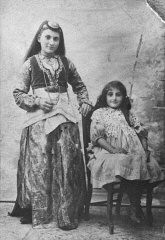
Ottoman military forces march Armenian men from Kharput to an execution site outside the city. Kharput, Ottoman Empire, March 1915-June 1915. [Courtesy of the Armenian National Institute.]
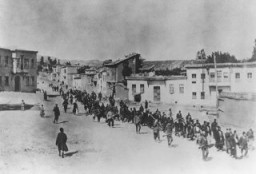
Ottoman troops guard Armenians being deported. Ottoman Empire, 1915-16.
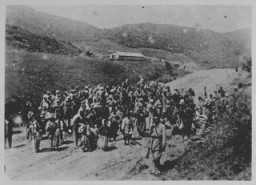
Armenian children lie in the street of an unidentified town. Photograph taken by Armin T. Wegner. Wegner served as a nurse with the German Sanitary Corps. In 1915 and 1916, Wegner traveled throughout the Ottoman Empire and documented atrocities carried out against the Armenians. [Courtesy of Sybil Stevens (daughter of Armin T. Wegner). Wegner Collection, Deutsches Literaturarchiv, Marbach & United States Holocaust Memorial Museum.]
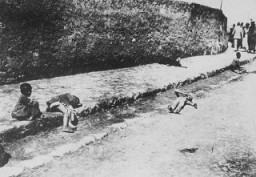
An Armenian refugee, wearing a scarf and a pack on her back. Ottoman Empire, 1918-20. Sometimes called the first genocide of the twentieth century, the Armenian genocide refers to the physical annihilation of Armenian Christian people living in the Ottoman Empire from spring 1915 through autumn 1916. There were approximately 1.5 million Armenians living in the multiethnic Ottoman Empire in 1915. At least 664,000 and possibly as many as 1.2 million died during the genocide, either in massacres and…
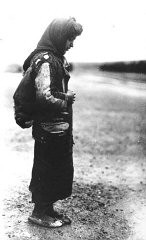
A small group of Armenian deportees walking through the Taurus Mountain region, carrying bundles. A woman in the foreground carries a child. Ottoman Empire, ca. November 1915. Photograph taken by Armin T. Wegner. Wegner served as a nurse with the German Sanitary Corps. In 1915 and 1916, Wegner traveled throughout the Ottoman Empire and documented atrocities carried out against the Armenians. [Courtesy of Sybil Stevens (daughter of Armin T. Wegner). Wegner Collection, Deutsches Literaturarchiv, Marbach…
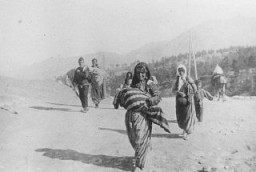
Armenian families next to makeshift tents in a refugee camp. Ottoman Empire, 1915-16.Photograph taken by Armin T. Wegner. Wegner served as a nurse with the German Sanitary Corps. In 1915 and 1916, Wegner traveled throughout the Ottoman Empire and documented atrocities carried out against the Armenians. [Courtesy of Sybil Stevens (daughter of Armin T. Wegner). Wegner Collection, Deutsches Literaturarchiv, Marbach & United States Holocaust Memorial Museum.]
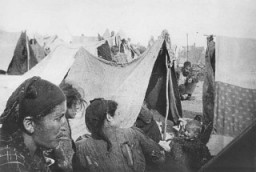
A group of Armenian refugees. 1915-20. Sometimes called the first genocide of the twentieth century, the Armenian genocide refers to the physical annihilation of Armenian Christian people living in the Ottoman Empire from spring 1915 through autumn 1916. There were approximately 1.5 million Armenians living in the multiethnic Ottoman Empire in 1915. At least 664,000 and possibly as many as 1.2 million died during the genocide, either in massacres and individual killings, or from systematic ill treatment,…
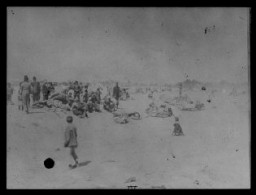
Armenian refugees in the desert. A man in the foreground lies on the ground on a layer of bedding. 1915-20.
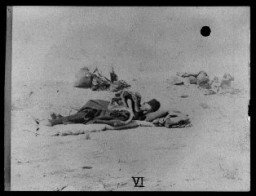
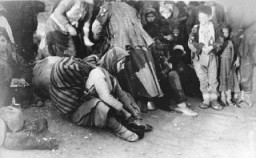
A group of 1,500 Armenian children at a refugee camp of the Near East Relief organization in Alexandroupolis. Greece, 1921–22.
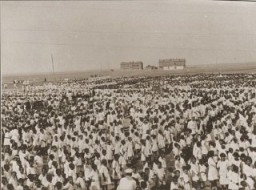
Refugees foraging at Alexandropol, Russian Armenia. Photograph taken by John Elder. In 1917, Elder, a divinity student from Pennsylvania, joined the American Committee for Armenian and Syrian Relief team that was aiding refugees. For two years, Elder did volunteer work with Armenian orphans. During that time, he photographed refugees and conditions at camps.
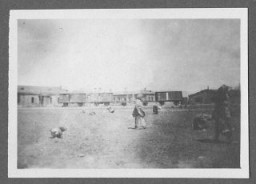
Père Jacques de Jésus (born Lucien Bunel) was a Carmelite headmaster of a Catholic boys school in Avon, France. Angered at Nazi policies, he made his school a refuge for young men seeking to avoid forced labor and for Jews. On January 15, 1944, the Gestapo raided the school, seizing Père Jacques and three Jewish children. The boys were deported to Auschwitz and killed. Père Jacques, sent to various concentration camps, died shortly after liberation.
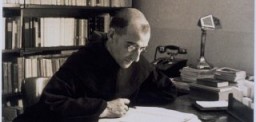
The title page of Mein Kampf by Adolf Hitler. This copy has an inscription by Hitler on the inside cover (not shown) that reads "To the Newlyweds with best wishes for a happy and blessed marriage." Munich, Germany, 1941.
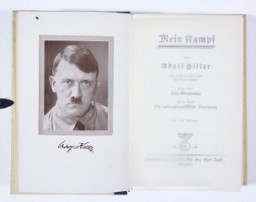
A US soldier inspects piles of Nazi books, including Mein Kampf, that were found in a German school. As part of their denazification policies, Allied authorities purged German libraries, bookstores, and schools of Nazi propaganda. Aachen, Germany, May 2, 1945.
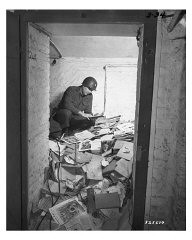
A young baby sits in its carriage next to a Quonset hut in Babenhausen displaced persons camp. Babenhausen, Germany, 1946-47.
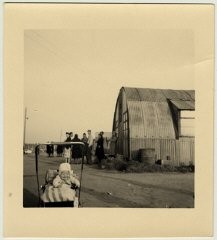
View of the road leading to the Deggendorf displaced persons camp. Deggendorf, Germany, 1945-46.
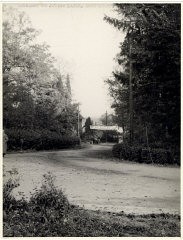
Zionist group gather with banners outside the Deggendorf displaced persons camp to demonstrate for Jewish immigration to Palestine. Deggendorf, Germany, 1945-49.
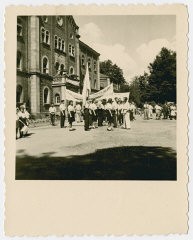
A young child sits among luggage while waiting to depart the Deggendorf displaced persons camp. Deggendorf, Germany, 1945-46.
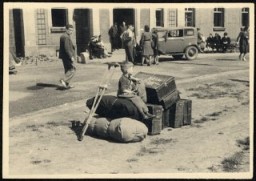
We would like to thank Crown Family Philanthropies, Abe and Ida Cooper Foundation, the Claims Conference, EVZ, and BMF for supporting the ongoing work to create content and resources for the Holocaust Encyclopedia. View the list of donor acknowledgement.